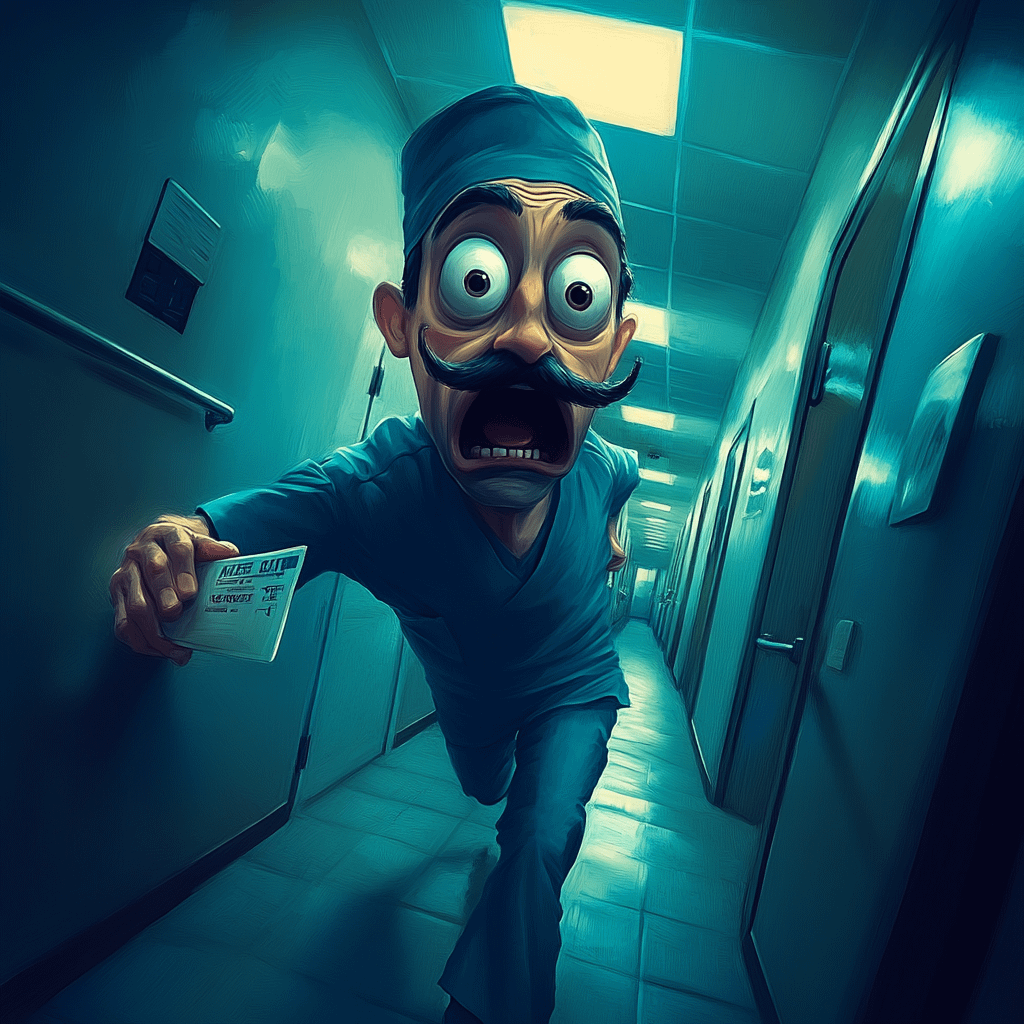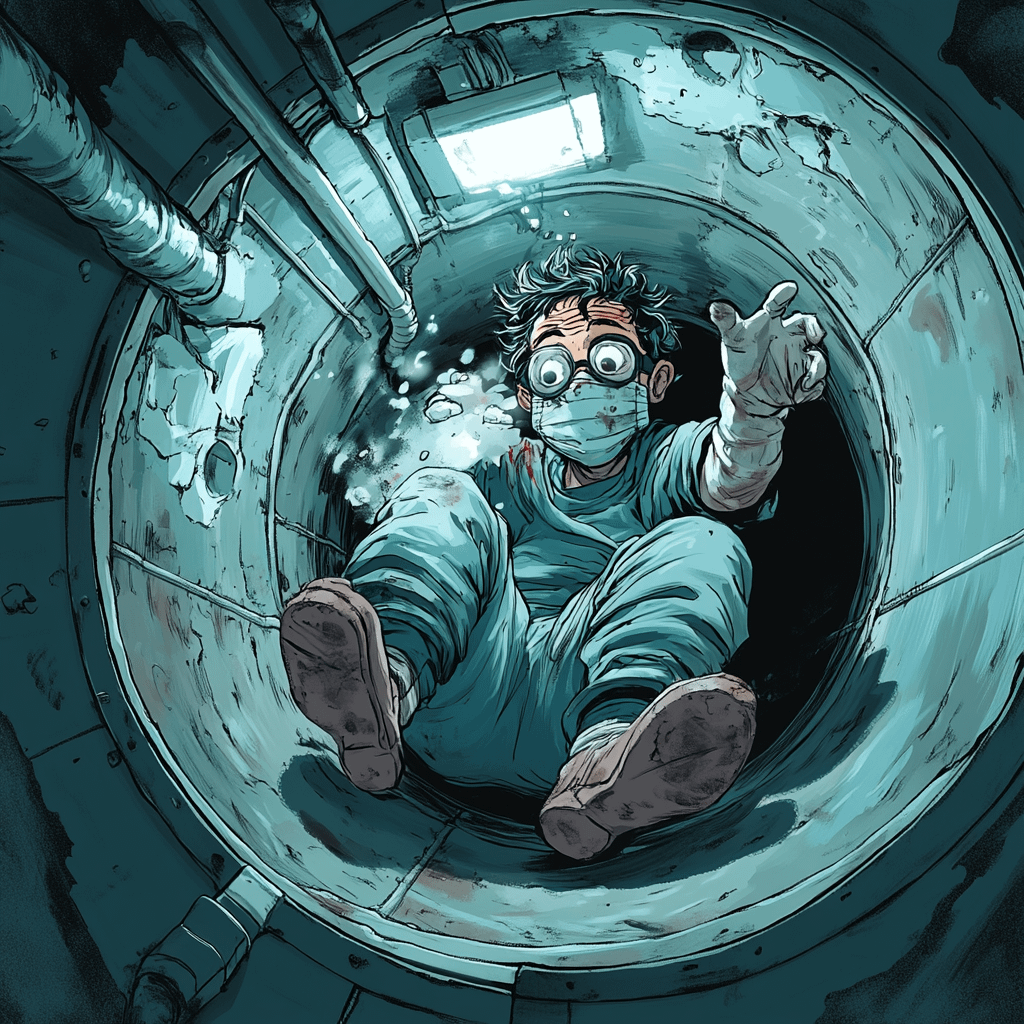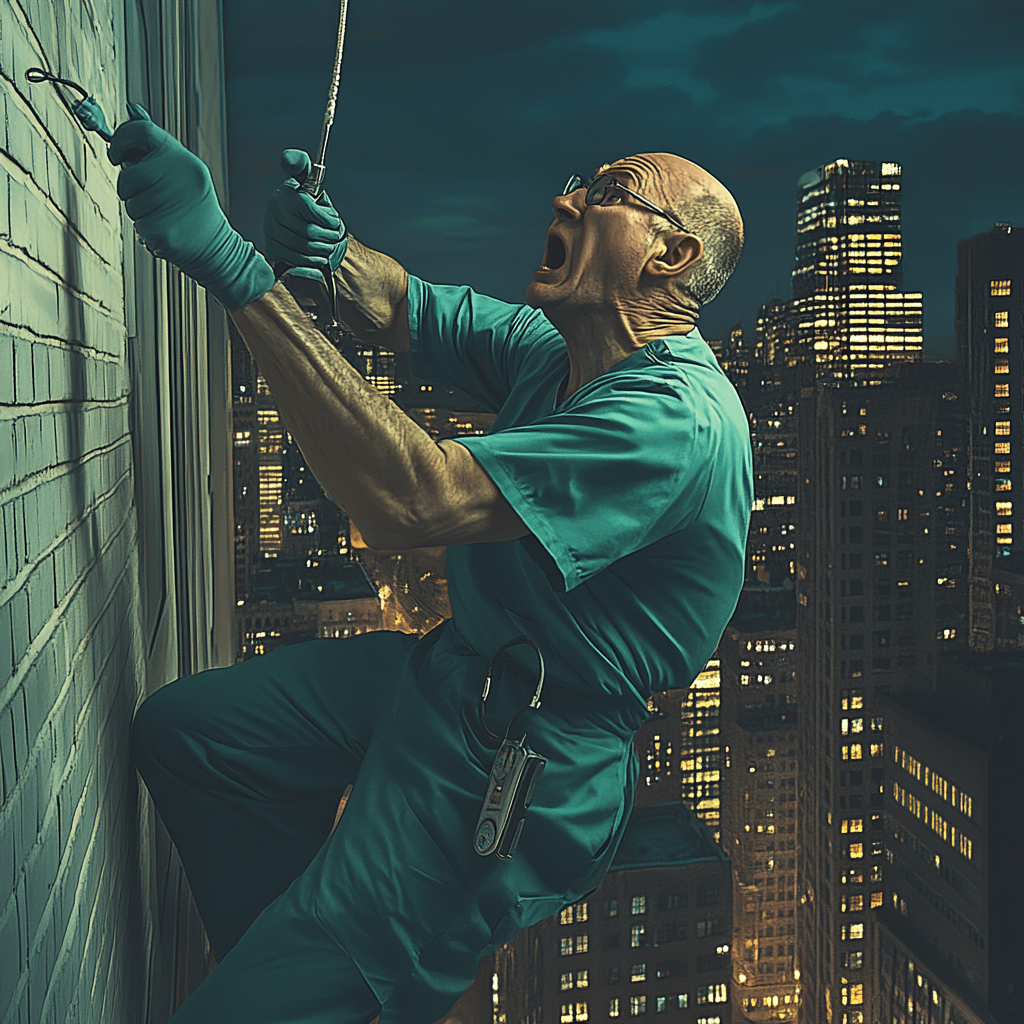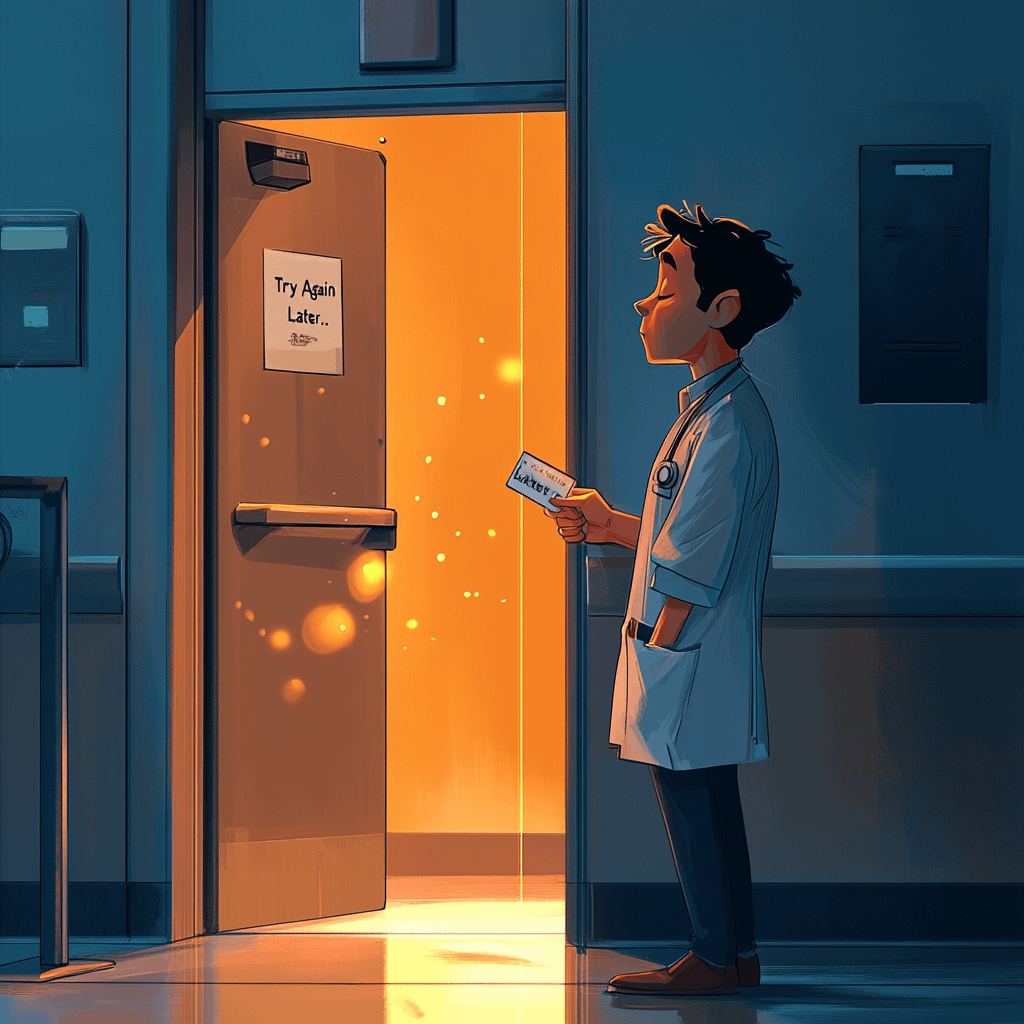Medical horror stories usually involve blood, lawsuits, or instruments mysteriously missing from the surgical tray. Mine? It started with urination. A heroic, high-stakes, life-threatening bathroom break.
One minute I’m in control—airway secured, propofol flowing, jazz playlist vibing. The next? I’m locked out of the OR like some underqualified ghost intern, watching my own case unfold through a tiny square of glass like it’s an escape room challenge I didn’t sign up for.
No badge access. No phone. No dignity. Just me, a locked door, and the creeping suspicion that I might have to enter through the f***ing ceiling like a raccoon anesthetist on bath salts.
Spoiler: It gets worse.
Table of Contents
So grab your stethoscope, suspend your disbelief, and prepare yourself—because this is one of those medical horror stories that makes you laugh, cringe, and seriously reconsider that second cup of coffee before a long case.

If you think getting locked out of the OR is peak chaos, wait until you witness The Scalpel Throwing Championship—truly one of the most unhinged medical horror stories we’ve ever (barely) survived.
Time to Enter Like a War Criminal or a Possessed Ghost
I’m locked out. The patient is inside. My phone is inside. And my badge? Now just a glorified piece of plastic, mocking me with every swipe.
First thought: Aspiration vent.
Could I fit? Probably not. Would I try anyway? Absolutely.
I yank off my clogs, eye the duct like a woman possessed, and briefly consider coating myself in surgical lube.
Second thought: Drop down from the ceiling like a sexy anesthesia-themed Spider-Man.
Except I’m wearing compression socks and a bun net. Less Marvel, more mental breakdown.
Third thought: Kick the door in.
But that would require upper body strength and plausible deniability. I have neither.
Fourth thought: Call for help.
Except—surprise! My phone is enjoying a sterile nap inside the OR, right next to my credibility.
I glance around. No one in sight. Just me and a door with the emotional intelligence of a brick.
Do I deserve this? Maybe.
Did I pee for 40 seconds and now risk intubating through a wall? Also yes.
The Aspiration Vent: My Brief Career as a Human Dust Bunny
It started as a joke.
A fleeting, unhinged thought: What if I crawl in through the aspiration vent?
And then my brain, high on cortisol and shame, whispered: Do it.
I scanned the hallway. No witnesses. Good.
Tugged a chair over.
Climbed up like a gremlin in scrubs.
And there it was—the sacred vent above the autoclave room. My gateway to redemption… or tetanus.
I removed the grill with a surgical pen and a lot of swearing.
Stuck one leg in. Then the other.
At this point, I am halfway in the vent, praying no one walks by and finds me ass-up in the HVAC system like some haunted HVAC technician.
I wriggle forward. I feel victory. I feel the ceiling dust coating my dignity.
And then—
I. Get. Stuck.
Hips jammed.
Scrubs pulled.
One compression sock hanging like a surrender flag.
This is it, I think. This is how I die. Trapped in a vent, mid-intubation crisis, like a surgically trained squirrel with nothing left to lose.
Eventually, I reverse out with the grace of a forklift having a panic attack.
Legs first. Shame second.
Back on the floor, breathless, dusty, and one vent cover short of a lawsuit.

Some medical horror stories begin with a locked door—others start when someone asks Can the Emergency Room Pull Teeth? and ends with everyone involved needing therapy.
Ceiling Tiles: Where Shame Meets Strategy
Plan B was born out of dust and despair.
If the vent won’t let me in, maybe the ceiling will.
I’ve seen enough spy movies to know this is always the next step. So I drag a stool over, climb up, and stare at the drop ceiling like it insulted my mother.
One gentle push and the tile lifts—revealing… pipes, wires, something suspiciously moist, and exactly zero viable entry points.
But logic left the building twenty minutes ago.
I hoist one knee up like a Cirque du Soleil dropout.
Pull my weight with the upper body strength of a chihuahua on caffeine.
And suddenly, I’m halfway through the ceiling with both arms shaking and one shoe dangling like the last shred of my reputation.
Then I hear it.
From inside the OR.
The sound of the resident’s voice.
And not the confident kind.
The “should the tube be this far out?” kind.
Panic strikes. I push harder.
The ceiling groans. My scrubs snag. My soul exits my body through my tear ducts.
Reality slaps me like a wet BP cuff: I’m not getting in this way.
I climb down. Quietly.
Place the ceiling tile back like nothing ever happened.
And tell myself this never leaves the hospital.
The Spider-Man Fantasy: Window Entry from Six Floors Too High
I rush to the window at the end of the hallway like I’ve just discovered a new religion.
From there, I can see the OR.
I can even see my phone—glowing smugly on the counter, like it’s live-streaming my failure.
And then the thought hits:
What if I go outside, scale the building, and break in through the OR window?
Yes, like Spider-Man.
Except instead of a spider bite, I have a herniated disc and a strong coffee addiction.
I run to the stairwell.
Peek out the emergency door.
Look up at the hospital’s glorious six floors of corporate hostility and bird droppings.
There’s no ledge.
No rope.
No common sense.
Just me, in Crocs, staring up at a third-floor window with the energy of someone one psych evaluation away from mandated leave.
I briefly consider fashioning a climbing harness out of anesthesia tubing and moral decay.
But then a gust of wind hits and I remember:
I have asthma. And anxiety. And zero health insurance coverage for idiocy.
I go back inside, defeated, trying to look like I was just… stretching.

And if you think getting locked out of the OR was bad, Being On Call: One Panicking Intern takes medical horror stories to the next level—with sirens, a helicopter, and enough adrenaline to power a small city.
If your hospital still hasn’t installed emergency bathroom pagers—and you’ve got trauma from that one time you were locked out mid-surgery—do yourself a favor and get this wireless call button. Stick it near the toilet, under the desk, or inside your vent crawlspace—wherever dignity tends to dissolve first. One press, and boom: instant rescue team (or at least someone curious enough to check the beeping).
The Fire Alarm Plan: For When You’re Ready to Lose Your License and Your Freedom
This is the moment where logic dies and survival mode goes feral.
I’m pacing. Sweating. One sock half-on. My career flashing before my eyes like a poorly edited slideshow.
And then it hits me:
Pull the fire alarm.
Not for fun. For justice. For airways. For patient safety, obviously.
Because nothing screams I’m a responsible healthcare professional like triggering a mass evacuation to re-enter an OR you left to urinate.
I eye the red box.
It winks at me.
I hear the faint voice of my med school ethics professor whispering, “don’t.”
But also the much louder voice of my inner chaos demon yelling, “DO IT, COWARD.”
Pros:
- Doors will unlock.
- People will panic and rush out.
- I might get in, intubate, and play it off like I was helping the fire department.
Cons:
- Jail.
- Unemployment.
- Becoming a Reddit thread titled “Medical Horror Stories: Dumbest Way to Lose Your Medical License.”
My hand hovers.
Then my brain kicks in—just barely—and reminds me that setting off an alarm might be slightly worse than, say, knocking.
So I walk away. Slowly.
Like someone who didn’t just consider committing arson for airway access.
The Knock of Shame: When You Abandon Dignity and Embrace Desperation
After vents, ceilings, window fantasies, and nearly triggering a building-wide evacuation, I did the unthinkable.
I knocked.
Not gently. Not politely.
I pounded on that door like it owed me money and a working key card.
At first—nothing.
Then a shadow.
Then the door creaks open just a sliver, and there she is:
The scrub nurse.
Eyebrows raised. Eyes scanning my dusty, defeated form.
“You good?” she says.
Like I hadn’t just tried to reenact every scene from Mission Impossible while mildly incontinent.
I slide in like like a blood-stained ghost of OR mistakes past.
The resident is pale, holding the laryngoscope like it might explode.
The patient’s still stable—thank science.
But the energy in the room?
Judgmental with a 70% chance of gossip.
I don’t speak. I just walk to the head of the bed, adjust my gloves, and take back control like nothing happened.
Except everyone knows something happened.
Something that will live forever in whispered nurse lore and anonymous Facebook threads tagged Medical Horror Stories.

For the Ones Who Keep the OR from Imploding
Behind every locked door and anesthesia crisis is a team that holds the line.
They roll their eyes, offer zero judgment (to your face), and somehow keep the patient—and you—alive.
They see you at your most heroic, your most ridiculous, and occasionally your most ventilation-duct adjacent.
This one’s for them.
The nurses who open the door without asking questions.
The residents who try their best with a shaking hand and a sweaty brow.
And the scrub techs who silently hand you your pride along with the laryngoscope.
In a world of medical horror stories, they are the reason the ending isn’t tragic.
Conclusion
Of all the medical horror stories I’ve lived through, this one takes the crown—and probably a few ceiling tiles with it. It reminded me that disaster can strike between bathroom breaks and badge swipes, and that sometimes the only thing standing between you and total chaos is a locked door… and a nurse with impeccable timing. Next time, I’ll bring my phone, my backup plan, and maybe a rope—just in case the ceiling calls again.
Still Here? Same.
If you’ve ever nearly performed an emergency airway through drywall, you belong with us. For more scrub-side sarcasm, questionable survival instincts, and passive-aggressive humor from behind the blue drapes…
Follow the chaos here:
Warning: side effects may include laughter-induced code blues.
